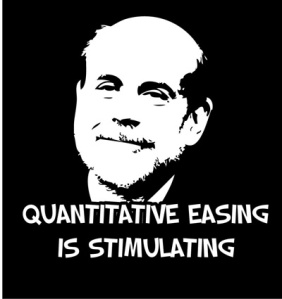Reading news about the recent QE 3, I never encountered even one writer giving a positive assessment of the FED’s action. This includes both professional journalists and bloggers. I think I read more or less 20 articles on this topic and I was surprised hearing a unanimous voice about the destructive effect of quantitative easing. In this post, I just want to collate relevant ideas I encountered from few of those articles. And allow me to start with a definition of quantitative easing.
Quantitative easing as defined by Investopedia is “a government monetary policy occasionally used to increase the money supply by buying government securities or other securities from the market.” The goal in quantitative easing is to increase “the money supply by flooding financial institutions with capital, in an effort to promote increased lending and liquidity.”
With the above definition, we understand that the overall goal in QE is to stimulate the economy by increasing the money supply. QE 3 shows that the previous QEs have not reached the intended goals despite the fact that in QE 1, a total of $1.7 trillion had already been pumped into the economy and in QE 2, $600 billion more had been added. And now in QE 3, the official announcement of the FED is to purchase $40 billion worth of mortgage securities a month until it reaches its goal of creating jobs for unemployed Americans. Actually, all the combined efforts of the FED to stimulate the economy will amount to $85 billion a month. This shows that the FED will not stop its “economic solution” not until it achieves its goal.
I think there is no question about the sincerity of Bernanke to aid the economy. The real problem lies in his basic misunderstanding of the economy due to his Keynesian-monetarist perspective. Compared to the solution offered during the 1930s Great Depression, the present strategy of the FED is in between the Keynesian and monetarist approach. As a Keynesian, Bernanke is incapable to see the FED as the source of the crisis. On the other hand, as a typical monetarist solution, the FED now is avoiding the mistake in the 1930s and increasing the money supply to provide liquidity.
The first article I read about QE is the one written by Dr. Ron Paul yesterday. He said, “Any further quantitative easing from the Fed, in whatever form, will only make our next economic crash that much more serious.” In Rilaly’s blog, the writer simply defines QE as basically printing more money and the blogger in Evil of Indifferencedescribes it as debasing the purchasing power of the dollar. I made a comment that this Keynesian-monetarist scheme of hiding inflation behind acceptable term actually misleads both the public and most professional economists. For me, it is better to replace “easing” with any word opposite to it for that is more accurate and honest. Checking the Thesaurus, you will come up with antonyms like distress, worsen, aggravate, and upset. So I think it is more appropriate to call the recent Fed action as “quantitative aggravating” or “quantitative distressing” for that’s what QE actually does. In the short-term, its detrimental effect on the economy is difficult to see, but if all the critics of QE are right (which I think they are), better prepare for a long rough ride ending to an economic crash.
Related Articles:
Description: For me, I consider it new to hear the voice of Donald Trump criticizing the Fed for its action. For Trump, though the recent QE would certainly benefit billionaires like him, the artificial boosting of the stock market by weakening the dollar through QE will not do long-term good not only for the US, but also for global economy.
Description: What calls my attention to this article is the picture of a little girl throwing lot of dollars out of the window. I think that is the appropriate picture describing the recent action of the FED.

No comments:
Post a Comment